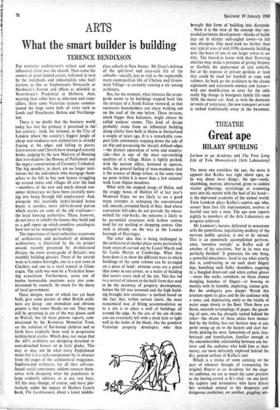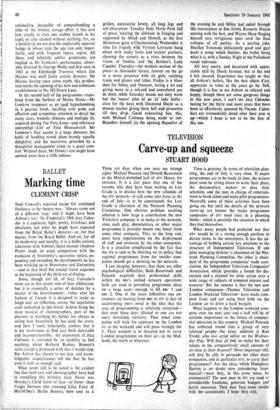THEATRE
Great ape
HILARY SPURLING
The more one considers the ape, the more it appears that Kafka was right about apes, as he was about most things: the ape—seedy, shambling, morose, abstracted, given to sudden violent gibberings, scratchings or cramming nuts into his mouth with the heel of his hand— is the depressed academic of the animal world. Tutte Lemkow plays Kafka's captive ape who, sooner than face life imprisonment, evolves at fearful cost into a man. The ape now reports nightly to members of the Arts Laboratory on progress achieved.
Mr Lemkow's lecture, delivered in monotone with the punctilious, ingratiating modesty of the nervous public speaker, is not to be missed. This is an immensely accomplished perform- ance, 'senseless enough,' as Kafka said of another of his creations, 'but in its own way perfectly finished.' It generates, for one thing, a powerful uneasiness : hard to say what exactly this is, confronting us on such short fidgety legs, hunching such bulky shoulders, capering in a bungled dress-suit and white cotton gloves —more like socks, somehow, on those clumsy dangling bunches of fingers—or bowing so meekly with its humble, imploring, simian grin. But the ambiguity goes deeper. Watch this creature upset its glass and fix the audience with a tense, sad, deprecating smile as the trickle of water seeps slowly to the floor. Then there are fierce, uncouth scrumplings of paper, the gnash- ing of nuts, one leg abruptly tucked behind the other—the shame of these antics here intensi- fied by the feeling that our lecturer may at any point swing up on to the lectern and start fur- tively picking his nose. Sensations of pain, fear, betrayal and humiliation, familiar enough in the uncomfortable relationship between any lec- turer and the audience who hold him at their mercy, are most delicately explored behind the dry, precise surface of Kafka's text.
Which is a stroke of some cunning on the part of whoever thought of transposing the original Report to an Academy for the stage.
As audience, we are in much the same position as the leering crowd at K's trial: on one level, the captors and tormentors who have driven this wretched animal to his desperate and dangerous evolution; on another, goggling sea- sationalists, incapable of comprehending a tithe of the intense, savage effort it has cost him simply to stick one stubby thumb in his lapel, or take alcohol without retching; for, on a third level, we are also the implacably superior beings to whose state the ape can only imper- fectly, and with frequent lapses, aspire. All these, and infinitely subtler gradations, are implied in Mr Lemkow's performance, admir- ably directed by George Mully and first seen in 1965 at the Edinburgh Traverse, where Jim Haynes was until lately artistic director; Mr Haynes having since come south, this produc- tion marks the opening of his new and ambitious establishment at No 182 Drury Lane.
In the second half of the programme—trans- lated from the Serbian of Moma Dimic—Mr Lemkow reappears as an aged hypochondriac in a peasant frock, recalling with pride and affection and scrupulous attention to detail the many scars, wounds, diseases and multiple ills acquired during The Very Long—and otherwise uneventful—Life of Tola Manoylevich. Mr Lemkow's Slav accent is a huge pleasure; his habit of handing round plum brandy equally delightful; and the mattresses provided by a thoughtful management come as a great com- fort. Without these, Mr Dimic's text might have seemed more than a trifle tedious.



































 Previous page
Previous page